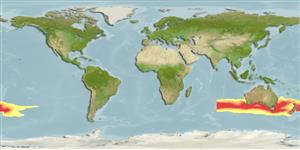Classification / Names
ชื่อสามัญ | ชื่อพ้อง | Catalog of Fishes(สกุล, ชนิด) | ITIS | CoL | WoRMS | Cloffa
sub class Elasmobranchii (ฉลามและกระเบน) (sharks and rays) >
Carcharhiniformes (Ground sharks) >
Scyliorhinidae (Cat sharks) > Scyliorhininae
Etymology: Cephaloscyllium: cephalus, from kephale (Gr.), head, referring to its very broad and depressed head; skylion, Greek for dogfish or small shark. (See ETYFish); albipinnum: albus (L.), white; pinna (L.), fin, but used here as a neuter adjective (finned), referring to distinctive white margins on fins. (See ETYFish).
More on authors: Last, Motomura & White.
Environment: milieu / climate zone / depth range / distribution range
นิเวศวิทยา
เกี่ยวกับทะเล,น้ำเค็ม สัตว์ผิวน้ำในเขตน้ำลึก; ระดับความลึก 126 - 554 m (Ref. 76947). Temperate
Indo-West Pacific: Southern part of Australia.
ขนาด / น้ำหนัก / Age
Maturity: Lm ? range ? - ? cm
Max length : 101 cm TL เพศผู้/กระเทย; (Ref. 76947); 102.5 cm TL (female)
Short description
เครื่องมือที่ใช้ในการแยกชนิดสัตว์,สิ่งมีชีวิตออกจากกัน | สัณฐานวิทยา | ความยาวต่างๆ
A large species with the following characters: head 8.6-13.5% TL in height, trunk 16.1-23.8% TL in width; origin of first dorsal-fin usually forward of mid pelvic-fin base; prenarial 4.5-5.1% TL in length; length of preorbital snout 1.4-1.7 times prenarial length, 2.5-3.1 in prepectoral length, 6.3-6.9 in pre-pelvic length; snout-vent long, its length 48.1-52.4% TL; width of nostril 2.4-2.7% TL; eye-spiracle space wide, 1.0–1.4% TL; pectoral fin large, its height 12.6-13.6% TL, posterior margin 12.0-13.6% TL in length; anal fin tall, height 3.8–4.4% TL; anal-caudal space 4.0-5.6% SL; precaudal length 74-78% TL; interdorsal space 6.3-7.6% TL; teeth with 3-5 cusps near symphysis of upper jaw; mainly weak tricuspidate flank denticles; back without greatly enlarged denticles; long adult clasper, up to 8.8% TL, almost reaching anal fin, interspace about 4.4 in anal-fin base; vertebral centra 121-126; tooth count high, each jaw with 90-116 teeth; strong pattern of saddles and blotches on upper half of body; dark, transverse dorsal markings (9-10) on body and tail, interspaces between are narrow; interspiracular saddle subequal to eye and spiracle length; over and above gill slits with large circular blotch; fins with variably developed, narrow pale margins (Ref. 76947).
Life cycle and mating behavior
Maturities | การสืบพันธุ์ | Spawnings | Egg(s) | Fecundities | ตัวอ่อน
Last, P.R., H. Motomura and W.T. White, 2008. Cephaloscyllium albipinnum sp. Nov., a new swell shark (Carcharhihiformes: Scyliorhinidae) from Southeastern Australia. In Last, P.R., White, W.T. & Pogonoski, J.J. (eds.): Descriptions of New Australian Chondrichthyans. CSIRO Marine and Atmospheric Research Paper no. 22. (Ref. 76947)
IUCN Red List Status (Ref. 130435)
Threat to humans
Harmless
Human uses
เครื่องมือ
Special reports
Download XML
แหล่งที่มาจากอินเตอร์เน็ต
Estimates based on models
Preferred temperature (Ref.
123201): 10.9 - 15.1, mean 12.6 °C (based on 44 cells).
Phylogenetic diversity index (Ref.
82804): PD
50 = 0.5000 [Uniqueness, from 0.5 = low to 2.0 = high].
Bayesian length-weight: a=0.00263 (0.00139 - 0.00497), b=3.21 (3.04 - 3.38), in cm total length, based on LWR estimates for this (Sub)family-body shape (Ref.
93245).
ระดับชั้นอาหาร (Ref.
69278): 4.2 ±0.5 se; based on size and trophs of closest relatives
ความสามารถในการกลับคืนสู่ปกติ (Ref.
120179): ต่ำ, เวลาต่ำสุดที่จะทำให้ประชากรเพิ่มขึ้นเป็น 2 เท่าใช้เวลา 4.5 - 14 ปี (Preliminary K or Fecundity.).
Fishing Vulnerability (Ref.
59153): High vulnerability (62 of 100).
